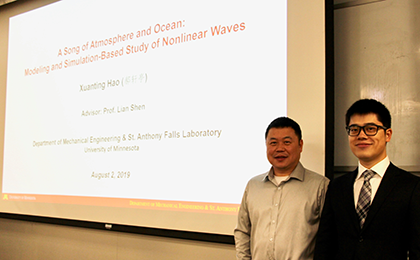Xuanting Hao defends PhD: A Song of Atmosphere and Ocean: Modeling and Simulation-Based Study of Nonlinear Waves

Ph.D candidate Xuanting Hao successfully defended his Ph.D in Mechanical Engineering on August 2nd, 2019. He is advised by Lian Shen of the St. Anthony Falls Laboratory and Department of Mechanical Engineering at the University of Minnesota.
Congratulations Dr. Hao!
A Song of Atmosphere and Ocean: Modeling and Simulation-Based Study of Nonlinear Waves
Xuanting Hao, PhD Candidate in Mechanical Engineering
Advisor: Lian Shen, SAFL Director and Professor of Mechanical Engineering
Ocean waves play a critical role in connecting the atmosphere to the ocean and shaping the global climate. Existing statistics wave models are inappropriate for the mechanistic study of wave dynamics with nonlinearity and irregularity. We present a systematic study on nonlinear waves using deterministic models, with a focus on the fundamental momentum and energy transfer processes between waves and motions in the atmosphere and ocean. Numerical experiments are first carried out for turbulent wind blowing over a wave field with various wind speeds considered. The results show that the waves have a significant impact on the wind turbulent energy spectrum. By computing the universal constant in a wave-growth law proposed in the literature, we substantiate the scaling of wind--wave growth based on intrinsic wave properties. Another group of numerical experiments are conducted to investigate the momentum flux between wind and waves in the coastal region. We quantify the form drag and find it considerably larger in the coastal region case than in the open sea case. Our findings provide the direct computational evidence in support of the critical role wave shoaling plays in the increased coastal wind--wave momentum flux. In the final part, we investigate the oceanic internal wave impact on the surface wave. We directly capture the surface roughness signature with a deterministic two-layer model to avoid the singularity encountered in traditional ray theory. The surface signature characterized by a rough region followed by a smooth region traveling with a nondispersive internal wave is revealed by the local wave geometry variation in the physical space and the wave energy change in the spectral space. Our findings show that the formation of the surface signature is essentially an energy conservative process and justify the use of the wave-phase-resolved two-layer model.
